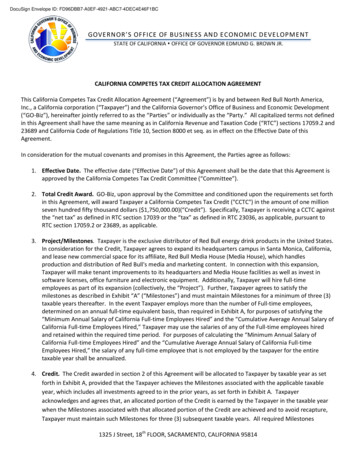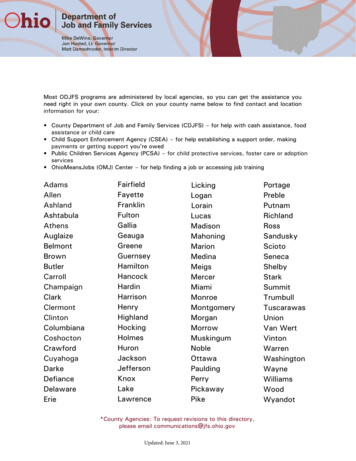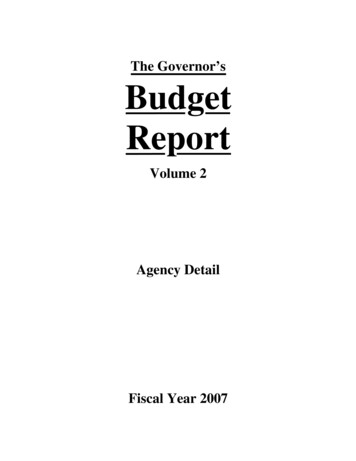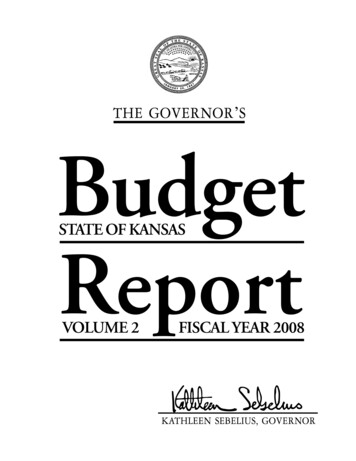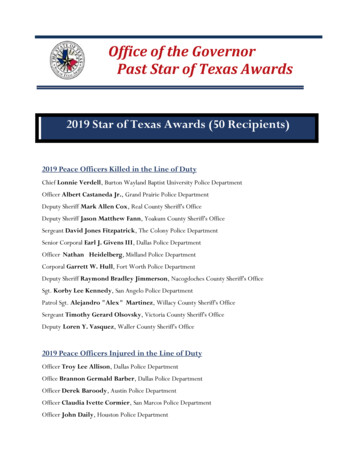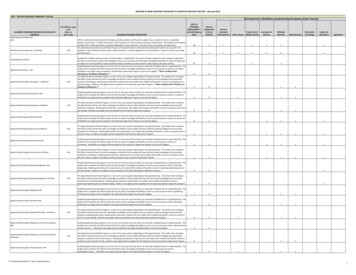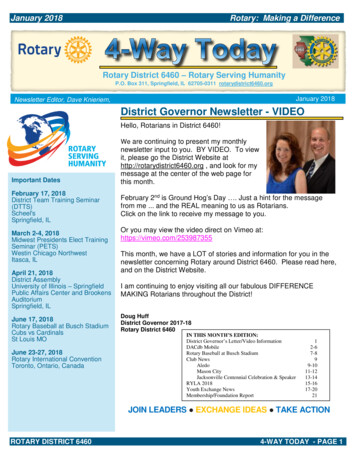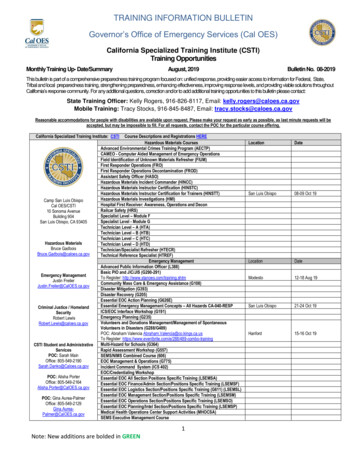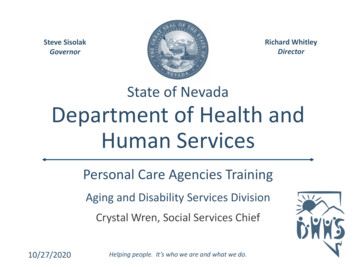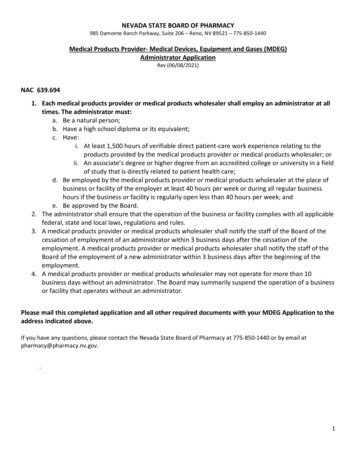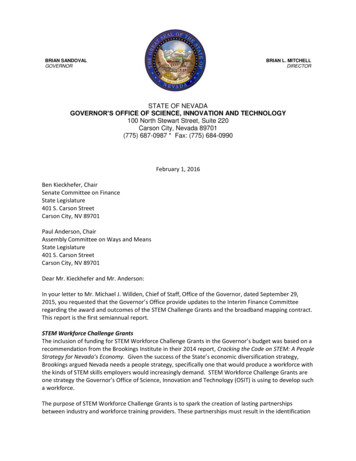
Transcription
BRIAN SANDOVALGOVERNORBRIAN L. MITCHELLDIRECTORSTATE OF NEVADAGOVERNOR’S OFFICE OF SCIENCE, INNOVATION AND TECHNOLOGY100 North Stewart Street, Suite 220Carson City, Nevada 89701(775) 687-0987 * Fax: (775) 684-0990February 1, 2016Ben Kieckhefer, ChairSenate Committee on FinanceState Legislature401 S. Carson StreetCarson City, NV 89701Paul Anderson, ChairAssembly Committee on Ways and MeansState Legislature401 S. Carson StreetCarson City, NV 89701Dear Mr. Kieckhefer and Mr. Anderson:In your letter to Mr. Michael J. Willden, Chief of Staff, Office of the Governor, dated September 29,2015, you requested that the Governor’s Office provide updates to the Interim Finance Committeeregarding the award and outcomes of the STEM Challenge Grants and the broadband mapping contract.This report is the first semiannual report.STEM Workforce Challenge GrantsThe inclusion of funding for STEM Workforce Challenge Grants in the Governor’s budget was based on arecommendation from the Brookings Institute in their 2014 report, Cracking the Code on STEM: A PeopleStrategy for Nevada’s Economy. Given the success of the State’s economic diversification strategy,Brookings argued Nevada needs a people strategy, specifically one that would produce a workforce withthe kinds of STEM skills employers would increasingly demand. STEM Workforce Challenge Grants areone strategy the Governor’s Office of Science, Innovation and Technology (OSIT) is using to develop sucha workforce.The purpose of STEM Workforce Challenge Grants is to spark the creation of lasting partnershipsbetween industry and workforce training providers. These partnerships must result in the identification
of STEM-specific skills needed by employers in Nevada and the creation of programs that provide theeducation and skills training to workers that match those needs, are aligned with present and futurelabor market information (LMI) needs in Nevada, and are sustainable after grant funds have beenexhausted. Funded projects provide training for and develop the STEM-specific, in-demand skills ofincumbent or displaced workers and/or traditional postsecondary students (18-24), leading to new orimproved employment opportunities in Nevada.One of the first priorities of the Governor’s Office of Science, Innovation and Technology (OSIT) was todesign and develop the STEM Workforce Challenge Grant. Mr. Brian Mitchell, Director of OSIT, led thiseffort. Mr. Mitchell met with public and private stakeholders from across the State to raise awarenessof the opportunity for funding, understand the workforce needs of employers, and understand theexisting capacity of the various public and private workforce training providers throughout the state.Early on it was determined that this grant opportunity would focus on sub-baccalaureate STEM skills,identified by Brookings as the maximum level of required education in half of open STEM jobs inNevada. Further, these types of jobs are projected to grow significantly as Nevada’s economy continuesto diversify. These jobs pay an average wage of 53,000 per year- 20,000 more than non-STEM jobsrequiring similar education levels. Despite the abundance of opportunity, the perception in Nevada andnationwide is that STEM careers require significantly more education than is the case. This grant isviewed in part as a strategy to call attention to these careers and target for training Nevadans eitherwithout or not planning to get a four-year degree. Given the focus on sub-baccalaureate trainingprograms, eligibility for funding was limited to community colleges, the state college, and other privateor public workforce training providers. UNR and UNLV were not eligible applicants due to their focus onbaccalaureate and above education.Based on feedback from employers, training providers, workforce development professionals, the StateGrants Office, and the Governor’s Office, Mr. Mitchell wrote the Request for Applications (RFA) anddistributed it in September. The RFA is included below as Attachment A. Total funding available inFY2016 was 1,000,000.At the October application deadline, OSIT received eight applications for funding. Mr. Mitchellconvened a review team made up of experts in this field and the applications were competitively scored.Three of the eight applications were funded totaling 334,975 in State funding. Five of the applicationswere given denial letters with feedback, and some were invited to reapply. Below is a description of thethree awarded applications:Truckee Meadows Community College (TMCC) has partnered with Switch, Inc. to develop a newtraining program for data center engineering technicians in anticipation of workforce demandscreated by Switch’s new SuperNAP site in northern Nevada. Graduates will be trained inoperations and maintenance of commercial heating and cooling systems. TMCC received a grantaward of 149,435 that will facilitate the acquisition of training equipment and simulators forthe TMCC Applied Technologies Center and for the development of the new curriculum.Additionally, Switch will donate a cooling tower to TMCC so that students can work with thesame equipment in the lab they would at Switch and will provide training to TMCC faculty.Graduates of this program will be qualified to work for a variety of industries including advancedmanufacturing, distribution and healthcare. Data from the Governor's Office of EconomicDevelopment shows that workers with these skills earn a median hourly wage of 22.58.
Specific project outcomes include: Installation of one commercial cooling tower for training at the TMCC AppliedTechnologies Center.Acquisition of three commercial-grade heating and cooling systems and three trainingsimulators for the TMCC HVAC/R lab.Completion of faculty training and an externship at the sites of industry partners.Development of new courses and course content based on the advice of industrypartners leading to a new AAS degree emphasis.First students enroll in Fall of 2016.As of December 31, 2015, TMCC is on schedule to complete the new program by the fallenrollment deadline. The first of five courses needed for the program, Cooling TowerOperation, has been completed. TMCC is working to select faculty, design the remainingcourses, and install the cooling tower after it has been decommissioned and transported fromLas Vegas to Reno.Western Nevada College (WNC) received a grant award of 150,000 to build a MechatronicsTraining Center and implement the Siemens Mechatronic Systems Certification Program,creating the only Siemens certified training center in the western United States. Training willfocus on advanced automated systems used in advanced manufacturing. Grant funding will beused to purchase equipment and fund instructor training by Siemens. The program will coverfields of electricity, mechanics, fluid power, and programmable logic controllers while alsoteaching important skills for advanced manufacturing including project management, processmanagement and optimization, cost controlling, safety, and effective teamwork. Students maygraduate at one of two levels: Level 1 trains students to understand the full system, thecomponents of the system and each device's role within the system and how to keep the systemrunning at maximum capacity. Level 2 emphasizes systems management, investigation, repair,and troubleshooting.Specific project outcomes include: Expanding and remodeling WNC's campus to house the WNC Mechatronics TrainingCenter (paid for with matching funds from the WNC Foundation).Purchasing the Advanced Mechatronics System (AMS), a training system fully alignedwith the Siemens training program.Developing Mechatronics curriculum and integrating best practices from Siemens. Thiswill include WNC faculty participating in Siemens-specific training.Marketing and recruiting students, enrolling an initial class for Fall of 2016. WNCestimates 40-60 students will enroll during the first semester and extended lab hourswill allow WNC to reach 200 students per year.As of December 31, 2015, WNC is on schedule to complete the program before the fallenrollment deadline. WNC has contracted to expand the Reynolds Building to develop a largerclassroom/lab for the advanced manufacturing program. WNC expects to purchase equipmentfor the lab and have it delivered before June 30, 2016. WNC is currently developing thecurriculum for the following courses:
Mechatronics: Electrical ComponentsMechatronics: Mechanical Components and Electrical DrivesMechatronics: (Electro) Pneumatic and Hydraulic Control CircuitsMechatronics: Digital Fundamentals and Programmable Logic ControllersMechatronics: Hands-On LabsNevada State College (NSC) received a grant award of 35,540 to increase the number of STEMteachers in rural Nevada. Rural postsecondary students will be able to complete their teachingdegree online, via distance education. Funding from the grant will be used to convert traditionalcourses into an online and interactive video format, and for the purchase of specialized cameraequipment. Students with a STEM-related associate's degree will be eligible to participate in thisspecial program designed to equip them with the skills necessary to teach math and science inthe classroom. NSC has partnered with WNC to recruit and prepare candidates for the program.The plan is supported by rural school district superintendents in Lyon, Storey, Churchill, CarsonCity and Douglas counties. NSC will begin recruiting students to start the program in July, 2016.NSC is on track to complete the program before it begins recruiting students. NSC is workingwith WNC to develop the program, identify specific schools and understand needs, and developmarketing materials to promote the program.Following the successful Round 1 funding, OSIT surveyed stakeholders on the RFA and the applicationprocess. Based on feedback received, OSIT made slight adjustments to the RFA and in November, 2015released the RFA for Round 2. The Round 2 RFA is included below as Attachment B. In Round 2, 665,025 remained in FY2016 from Round 1. Applications were due January 11, 2016 and OSITanticipates making award announcements in early February. More information on these awards will beincluded in OSIT’s next report.Later this spring, OSIT plans to release the Round 3 RFA to award 1,000,000 in FY2017 funding.Broadband MappingIn today’s connected society, access to broadband is increasingly less a luxury and more a necessity foreconomic development, business, education, healthcare, and for use by the general public. In both hisState of the State and his budget, Governor Sandoval gave significant attention to improving broadbandaccess, assigning the task of coordinating broadband connectivity to OSIT. Sufficient connectivity is animportant component of the Nevada Ready 21 plan, which gives middle school students their owndevice and teachers the necessary professional development to incorporate them into daily instruction.To assist the State with the continued mapping, planning and development of broadband, theGovernor’s budget included funding to retain the services of Connect Nevada, a non-profit working withthe State since 2009. In 2009, Congress included funding for broadband grants to states in the AmericanRecovery and Reinvestment Act, established in the US Department of Commerce as State BroadbandInitiative grants. Connect Nevada, a subsidiary of Connected Nation, was chosen as Nevada’s statedesignee for the grant. From 2009-2014, during the period of the federal grant, Connect Nevadaworked with the Governor’s Broadband Task Force on policy development, created maps of broadbandcoverage, conducted surveys, and wrote the State Broadband Action Plan in November 2014. The plancan be found here: http://www.connectnv.org.
Following the passage of the bill, OSIT negotiated a two-year contract with Connect Nevada, which wasapproved unanimously by the Board of Examiners in September, 2015. The contract funds a full-time,Nevada-based program director, mapping and data analytics services, a GIS analyst, contracted fieldengineers, software, and administrative support. Connect Nevada works directly with OSIT’s BroadbandManager, Britta Kuhn. Contract deliverables include: Provide to the Governor’s Office of Science, Innovation, and Technology (OSIT) an annual updateto the Nevada broadband map to refresh last mile broadband availability (once in December2015 and once in December 2016);Work at the direction of the NV Broadband Task Force (NVBTF) and OSIT to develop for the firsttime a middle mile broadband infrastructure map so that the state can understand currentcapacity for transporting broadband service out to rural communities, and what opportunitiesmay exist to help close broadband availability gaps and speed deficiencies;Provide staffing, in the form of a state program Executive Director, to support the work of OSITand NVBTF—particularly in coordination across state agencies, local governments, broadbandservice providers, and other large capacity fiber/microwave operators to develop the middlebroadband map and identify solutions for improved last mile service in rural communities;Work at the direction of OSIT to assist the state implement recommendations from the StateBroadband Action Plan;Meet with OSIT upon request to provide updates on contract deliverables; andUpon request of OSIT, Connect Nevada will provide consultation and application assistance toNevada state agencies applying for broadband or E-Rate grants from the federal government orother sources.Connect Nevada’s activities since September can be divided into three categories: strategic meetingswith providers, strategic meetings with state and local government, and mapping.Strategic Meetings with ProvidersStaff from Connect Nevada, together with Ms. Kuhn, have met with representatives of the State’slargest broadband providers including AT&T, Switch, Arizona-Nevada Tower Corporation, LightcoreGroup Inc., NV Energy, Red Rover Ltd., CenturyLink, Network Services Solutions, and others to discussfiber infrastructure in the State, future build-out plans, ways to leverage existing infrastructure, and howprivate-sector providers could collaborate with the State to meet the needs of underservedcommunities. Connect Nevada staff have also had discussions with several providers regardingleveraging federal funding, such as E-rate, to connect rural schools, hospitals, clinics, and other ruralcommunity anchor institutions to the internet. Switch and NV Energy have been particularly open toworking with the State to achieve these goals. Staff also met with one provider regarding future buildout in north and northwest Las Vegas, building on previously received federally funded BroadbandInitiatives Program grants.Strategic Meetings with State and Local GovernmentMeetings in this category often include representatives from private-sector providers as ConnectNevada has made it a priority to bring the public and private sectors together. For example, ConnectNevada has had several meetings in community and government leaders Mt. Charleston regarding theviability of various broadband solutions. Representatives from Arizona-Nevada Tower Corporation andCenturyLink have also participated in these meetings. Connect Nevada has worked with Kim Vidoni,Director of Education Technology Programs at the Nevada Department of Education and others working
on the Nevada Ready 21 plan to organize a monthly conference call with Chief Information Officers inevery Nevada school district to discuss forming E-rate collaboratives that could maximize buying powerin rural parts of the state. Connect Nevada staff also organized a series of meetings with theDepartment of Education and Network Services Solutions to discuss possible fiber/microwave solutionsfor central Nevada schools.MappingIn December, Connect Nevada produced a refresh of its last-mile availability map for the state. Themaps are included as Attachment C below. The interactive map application availability layers have alsobeen updated at http://map.connectnv.org. Additionally, Connect Nevada staff have begun workingwith public and private sector fiber network operators to collect middle mile fiber information for useon a statewide middle mile infrastructure map.ConclusionThis concludes the first report. OSIT will submit its next report on or before July 31, 2016. If you haveany questions in the interim, please do not hesitate to contact me.Brian Mitchell, DirectorGovernor’s Office of Science, Innovation and Technology
Attachment A
Attachment B
Attachment C
As of December 31, 2015, TMCC is on schedule to complete the new program by the fall enrollment deadline. The first of five courses needed for the program, Cooling Tower Operation, has been completed. TMCC is working to select faculty, design the remaining courses, and install the cooling tower after it has been decommissioned and transported from

